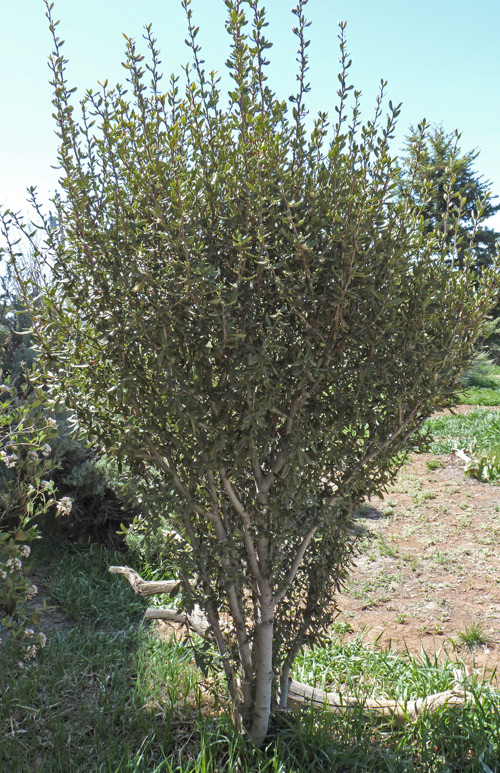By Jenifer Heath

I have spent several years transforming my yard and specifically building low-water (xeric) and mostly native plant habitat for pollinating insects, and only incidentally for birds and other creatures. This winter I decided that I’d like to make a bigger effort to support birds specifically. Bird habitat should provide water, food, shelter and a place to reproduce and raise young. An adjacent neighbor has a pond (water source) and most of my neighbors have mature evergreens (as old as 60 years) and I’ve been told that many of these are native.
This article focuses on food and cover/shelter. As we know, native plants are the best way to improve habitat, so I’ve been reading about native shrubs. I felt that what was really missing in my yard for birds is shrubs to serve as an understory where I have taller trees, and to provide fruit and shelter and safety from the neighborhood outdoor cats and other predators. So over recent months I’ve done some research and reading and planning and replanning and ordering (too many) shrubs.
Many people are much more specific and precise about what they consider native for their yard, but my own guideline is a strong preference for plants native in Colorado (or to a lesser extend adjacent states) and that I hope will thrive with a variety of moisture and sun conditions in different parts of my yard, not to mention my soil type.
Based on my reading, I decided to follow the guideline that a grouping of shrubs is of greater value to birds than are those same shrubs scattered singly around the yard. I found a “recipe” for a native wildlife hedgerow in a National Wildlife Federation article. It could be a hedgerow, implying linearity, as to provide privacy or define a space, but could also be shaped differently. Neat clean pruning and generous spacing are less beneficial to birds than is a more natural plant shape and significant overlap between shrubs.
We can think of native shrubs not only as smorgasbords of nutritious foods, but also as safe passageways through our yards for birds and other wildlife. Consider using native shrubs to connect islands of native plants and the shrubs will provide cover as animals move from one island to another.
The National Wildlife Federation suggests diversity in the shrubs we include (rather than planting a uniform row of a single species) to support a wider variety of wildlife. Their “recipe” is “… one evergreen species, two nectar-producing species, two berry-producing species and one thorny species.” I’m not arranging my shrubs as a hedge, but I took this mix as a good guideline for my yard overall.

I have learned that rose hips are a powerful and important winter food for many birds. As mentioned above, sharp shrubs protect birds (and other prey) from predators. Although I despise dealing with sharp shrubs, my lifelong reaction was overpowered by the importance to me of providing habitat. Also, I don’t have children playing in my yard and I can put sharp plants in places that are not accessible to my pets. Many people use sharp shrubs to discourage trespassing on their property. I’m going to plant some native roses and near native roses, Rosa woodsii and Rosa blanda, in livestock troughs with the hope that the trough bottom and walls will control suckering and crazy lateral growth of these thorny, thicket-forming native roses.
Like most of us I am limited in terms of space and types of space that I have in my yard for shrubs. There are many, many different shrubs that are native to whatever your definition of native is and will thrive in different moisture and sun/shade and soil conditions. Some are quite short (yet still can be part of a cover pathway through your yard) and others may become small trees. You may have realized that some shrubs fall into more than one of the NWF’s categories, such as evergreen and berry-producing, or thorny/sharp and nectar-producing, so we can check off two “ingredients” with one plant. And, of course, any plant that attracts insects (and especially larval host plants) is by definition attracting food (insects) for birds.
My shrub wish list includes: Ribes aureum (currant), Rubus deliciousus (Boulder raspberry), Ericameria nauseosa (rabbitbrush), Cercocarpus ledifolius and Cercocarpus intricatus (curl leaf mountain mahogany and little leaf mountain mahogany), Cornus sericea or stolonifera (red twig dogwood), Symphoricarpos orbiculatus (coral berry) (shorter and thicket forming), Prunus besseyi (Pawnee Buttes sand cherry), Arctostaphylos uva-ursi (kinnik kinnik), Mahonia (or Berberis) repens (creeping Oregon grape), Falluja paradoxa (Apache plume), Rubus parviflorus (thimbleberry), Berberis fendlerii (fendler’s barberry), Rhus trilobata (skunkbush), Prunus andersonii (desert peach – not native to Colorado), Sambucas canadensis (elderberry), and Chamaebatiaria millefolium (fernbush – not native to Colorado). Some of these may have fruit that is great for birds, but may be toxic to small humans or some other mammals.



Read more about the benefits of incorporating Colorado Native Shrubs in your landscape in this article: Plant Colorado Native Shrubs – They are Ecological Powerhouses.
The author’s favorite sources of information related to creating habitat for birds:
Attracting birds, butterflies and other backyard wildlife. David Mizejewski (National Wildlife Federation). 2019. (This was my very favorite/most useful.)
National Wildlife Federation, including its Native Plant Finder, where you may enter your zip code and see how many species various native flowers, grasses, trees and shrubs support.
Native Plants for Birds handout by Audubon Rockies, Denver Audubon, Colorado State University Extension, and Colorado Native Plant Society.
Various webpages from Cheyenne-High Plains Audubon Society, Denver Audubon, Audubon Rockies and American Bird Conservancy.
The websites of plant sellers Prairie Nursery and Prairie Moon along with their native range maps.
Curious to learn more about transforming your garden into a habitat with Colorado native wildflowers, grasses, shrubs, and trees? Check out our native gardening toolkit, register for an upcoming event, subscribe to our newsletter, and/or become a member – if you’re not one already!
